|
==============================================================================
TOPIC: Great trees of Ohio
http://groups.google.com/group/entstrees/browse_thread/thread/796cba77dc829f54?hl=en
==============================================================================
== 1 of 4 ==
Date: Sun, Jul 20 2008 10:19 am
From: "Will Blozan"
ENTS,
Last week I had the opportunity to visit some fine trees in Ohio
while
visiting in-laws. I was graciously led around
"who-knows-where" and back by
Brian Riley, Service and Watershed Forester for the Division of
Forestry,
Ohio Department of Natural Resources. Brian and I have emailed and
called a
few times over the last year about big trees and measurement
guidelines. We
are definitely on the same page about the errors on the American
Forest
National Register of Big Trees and other concerns we have all
discussed
before. He maintains an excellent Ohio Champion Tree listing that
has
separate sections for native and exotic species. He has personally
visited
and measured most of them and has a keen eye as witnessed by his
discovery
of a National Champion Ohio buckeye while on a road construction
detour. It
was great to spend a day with him, be introduced to some of his big
tree
finds, talk trees and introduce him to the use of the ENTS method
for tree
heights. He was impressed with the ease of the laser use and I
showed him
first hand the limitations of the tangent-based system. Here is the
Ohio
Champion Tree list:
http://ohiodnr.com/forestry/bigtrees/default/tabid/4806/Default.aspx
We met in Bowling Green, Ohio the morning of July 14th. But before I
met him
I took a scenic driving route along the Maumee River from
Perrysburg, Ohio
where I was staying. I immediately noticed a small park enticingly
called
"Buttonwood Recreation Area"
(http://www.woodcountyparkdistrict.org/BUTTONWOOD.htm).
Cottonwood would
have been a better name as they were quite dominant with an
occasional
sycamore, silver maple, bitternut hickory, box-elder, red elm or
crack and
black willow. The cottonwoods formed a dense, tight canopy up to 130
feet
high. I was searching for a tall silver maple but did not find any.
On the
way in I noticed that no one was camping in the park. As soon as I
got out
of the car I realized why- MOSQUITOES!!!! I bolted after ~20 minutes
of
survey and bloodshed.
I still had some time after I fled the buttonwood park and while
driving
random streets in Bowling Green I spotted a REALLY wide spreading
tree of
unknown species. I turned around and found the tree to be in a city
park.
Turns out it was a Siberian elm (Ulmus pumila) of huge dimensions
(at least
for me- they get much bigger Brian tells me). This whopper of an
introduced
tree scaled a hefty 16.1 feet cbh, 70.2 feet tall and an average
spread of
112 feet (longspread 118.5 feet). Awesome!
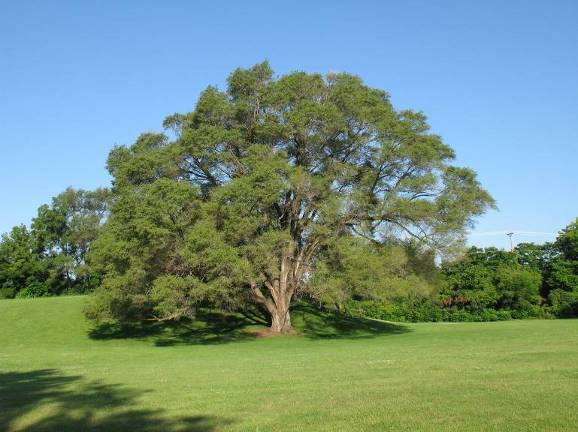
Siberian elm in Bowling Green
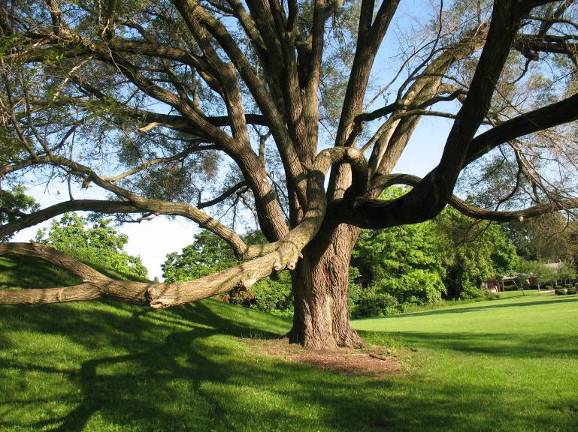
Giant trunk of 16.1' Siberian elm in Bowling Green
I soon met up with Brian and we headed first to a massive white
willow
(Salix alba) that was a contender for a National Champion (as a
naturalized
species). It had not been measured for years and Brian was not sure
if it
was still there. Well it was, dominating the entire back yard of a
small lot
in Bowling Green, Ohio. We set about the measurements and I probed
all over
with the laser to find the highest spot. It looked taller than the
76.6 feet
I measured but the massive trunk girth of 20'9" was visually
supported by
the wall-of-wood at eye level. Another exotic- but impressive
nonetheless. I
am not sure how it ranks now as a contender since it was shorter
than
previously measured @ 96 feet. This tree also gave me the
opportunity to use
the laser to measure spread on a remote tip not accessible from the
ground
due to obstructions. Standing in one location, I shot the distance
and angle
to the far tip, calculated the horizontal distance and then added
the
remaining distance to the other side of the crown behind me.
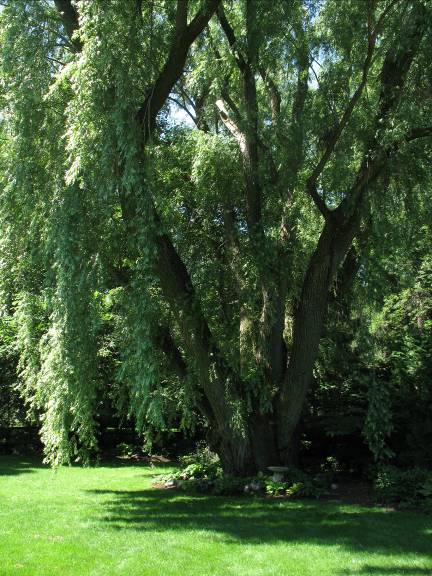
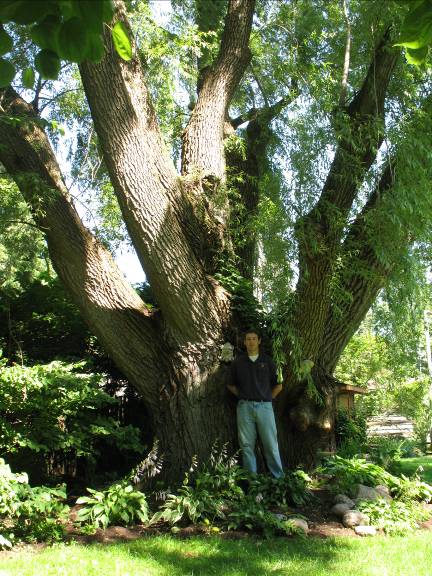
Brian Riley and the huge white willow in Bowling Green, Ohio
We next went to a huge hackberry in Findlay, Ohio. This twin beast
was an
imposing mass of wood on a back alley. The nature of this tree is
under
debate; some say it is a twin others a single stem. I definitively
would
call it a twin probably of stump-sprout origin. Regardless, this
impressive
tree has grown to 22'3" of girth and 80.7 feet in height. I
suggested a
frame mapping of the lower trunk to separate the main trunk from the
much
smaller stem. I estimate it would still be over 17' in girth. Sorry,
no
photo.
On route to see the National Champion Ohio buckeye, Brian drove by a
HUGE
white ash that used to be the state champion (yes, there is a bigger
one!).
This 18'7.5" untapered chunk of wood was the largest ash
diameter I have
ever seen! The tree was quite stocky and less than 80 feet tall, and
will
likely succumb to emerald ash borer in the next few years. I was
appalled
(as I am here in the southern Appalachians treating hemlocks) at the
number
and quality of ash trees left to die in peoples yards and streets.
As with
hemlocks, there is a simple, cost-effective solution to save these
trees yet
they needlessly die by the hundreds.
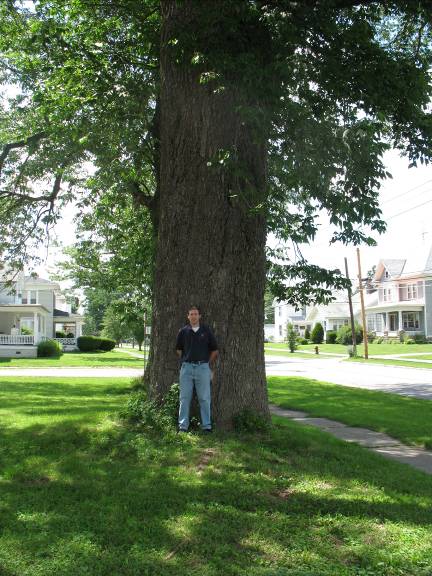
Brian Riley and the huge Findlay Ash
We arrived at the Ohio buckeye after quite a drive through the
agricultural
countryside of northern Ohio. Open skies were a novelty to me as
were
long-range horizontal vistas. Brian was able to point out other
state
champion trees from considerable distance and I got to see the first
giant
windmill generators I have ever seen. The buckeye grew alongside an
old farm
house with a protective dog that could eat a horse in two bites.
Both were
large, formidable beasts with dangerous bark. The buckeye was
covered in
poison ivy and the dog threatened to eat my hand and then floss with
the
wire from the uncomfortably inadequate 5 foot high fence. The laser
again
came in handy to measure the spread which was (of course) directly
over the
flimsy dog enclosure.
After careful measurements we found the tree to have grown a few
inches in
girth and maintained its listed height at 77 feet (laser=76.5) feet.
The
girth was dead on 12 feet and the gnarl factor was very high. Crown
spread
averaged 61 feet with a long spread of 64.5 feet. I was VERY
impressed with
this tree and would love to climb it someday. A worthy National
Champion for
sure! A fine collection of automobiles graced the site as well ;)
This tree concluded the day spent with Brian, who left with the ENTS
guidelines in hand and a great desire to obtain a laser! He openly
welcomes
any help ENTS can give and I especially want to hook him up with Tom
Diggins. He is more than willing to have ENTS work on verifying
nominations
and remeasureing trees in parts of the state remote to him. Tom? Are
you out
there? One nice feature of Brian's Champion Tree list is it includes
the top
three of a species based on AF big tree points. This allows more
trees to be
listed and I hope my Siberian elm makes it on the list! Many thanks
go to
Brian for taking the time to spend the day with me and guide me to
some
excellent trees. He is a great supporter of the ENTS and has a great
desire
to make the Ohio Champion Tree list as accurate as possible. Indeed,
it is a
great list as he is a stickler for accuracy and an incredible
botanist as
well.
The next day I met up with Steve Harvey, North District Preserve
Officer for
the Division of Natural Areas and Preserves, Ohio Department of
Natural
Resources. I was given Steve's contact by Brian Riley since a large
American
chestnut (state champion) was discovered on one of the preserves
under
Steve's management. I emailed Steve and he invited me up to measure
the tree
at Sheldon Marsh State Nature Preserve near Huron, Ohio. We found
the tree
in full bloom- a complete dome of white flowers. This forest grown
tree
reached an eastern record height of 88 feet. The trunk, unmarred by
blight,
looked like a northern red oak and had begun to furrow into a
diamond
pattern. At 65" in girth this is the largest I have seen in the
eastern US.
The tree is just on the edge of the natural range of the species and
hopefully its isolated location will afford it many years of growth.
Talking with Steve further, he mentioned a huge sassafras on a
preserve he
was just leaving to patrol. I followed him there. After about 800
turns we
arrived at Augusta-Anne Olsen Nature Preserve in Huron County
(http://ohiodnr.com/location/olsen/tabid/955/Default.aspx).
The flat fields
of the surrounding landscape gave no hint of the steep drop at the
edge of
the fields into an old oxbow of the Vermilion River. The incision of
the
oxbow into the landscape formed a sort of "cove" with
about 60 feet of
relief from the flat landscape above to the river. A series of
trails
traversed the site offering a good view of the forests there.
Species
composition indicated a rich soil and the site is well known for the
wildflower displays in the spring. However, exotic earthworms have
denuded
the forest floor to bare soil and a few scattered plants, mainly
Jack-in-the-Pulpit. Truly a tragedy...
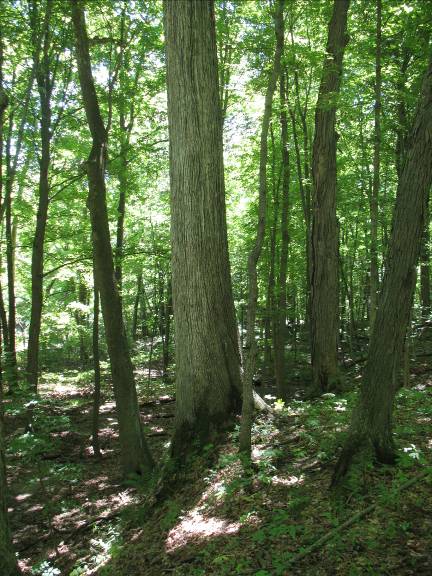
Augusta-Anne Olsen Nature Preserve White Oak
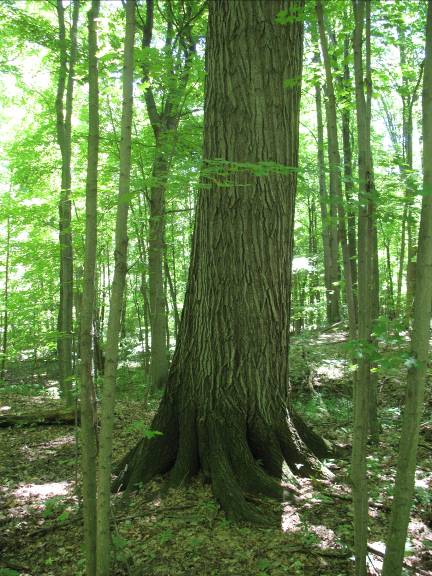
Augusta-Anne Olsen Nature Preserve Red Oak
The young forest had a great diversity of canopy trees and although
young,
shows great promise as a tall tree site in the future. The canopy
reached
~120 feet and had some awesome examples of huge red and white oaks
as well
as white ash. Emerald ash borer had already killed a bunch of the
ash trees.
The American beeches were phenomenal and red maples were of
exceptionally
nice form. I measured another nice American chestnut at 35.2"
cbh X 85 feet,
although its top had died from chestnut blight. With a bit more
searching
this site could support a Rucker Index of around 120. The leafy
canopy was
way too dense to get solid shots and fully explore the maximum
heights.
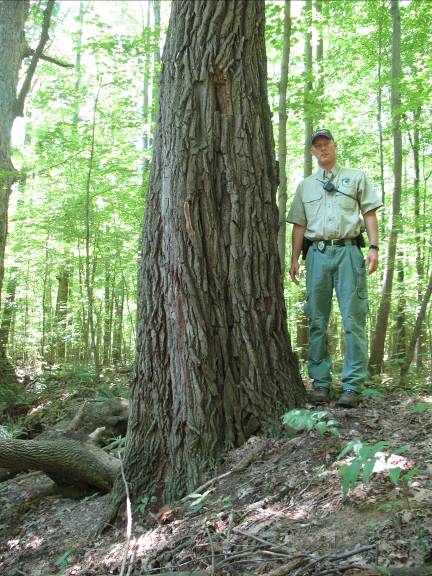
We reached the sassafras and found it to be 10'1" in girth and
87.9 feet
tall in Augusta-Anne Olsen Nature Preserve
Some
measurements
Species
Girth and height
American
chestnut 2.9’
X 85’
Red
maple
7.1’ X 110.5’
American
beech
8.2’ X 120’
Red
maple
11’1” X 112.7’ (twin)
Sour
cherry (?)
2.7’ X 88.3’
White
ash
10.4’ X 118’
Black
cherry
3.9’ X 118’
Sycamore
4.6’ X 119.2’
Cottonwood
11.1’
X 120’
Tuliptree
4.2’ X 120’+
Ohio
buckeye
5.4’ X 78.3’
Bitternut
6’ X 108.4’
N.
red oak
7.9’ X 109’
N.
red oak
9.6’ X 110.9’
White
oak
12.4’ X 105.3’ (pictured above)
N.
red oak
11.8’ X 105’ (pictured above)
Bitternut
5.6’ X 119.9’
Butternut
5.5’ X 82’
Sassafras
10.1’ X 87.9’
Quaking
aspen
3.7’ X 80.7’
Quaking
aspen
3.9’ X 87.9’
I appreciate Steve's patience during my
measurement spree and thank him for
taking me to the site. It is an impressive place with serious
potential to
produce some tall trees. We split up after walking the trails and I
proceeded to two trees Brian Riley asked me to check out and
measure.
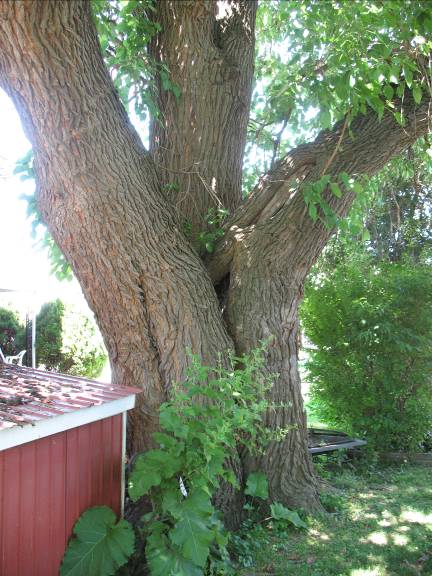 White Mulberry
White Mulberry
The first tree was in Fremont, Ohio. Here grew
an absolutely massive white
mulberry (Morus alba) that contained, among serious decay, a huge
squirrel
and feral cat. The cat was not pleased with my tape wrap and almost
scared
the mulberries out of me! The owner was very pleased with the
attention the
tree was getting and was quite proud of her tree. Unfortunately the
tree is
splitting and one side is completely dead. I measured the height at
60.5
feet and the girth of at least three fused stems was 20'11".
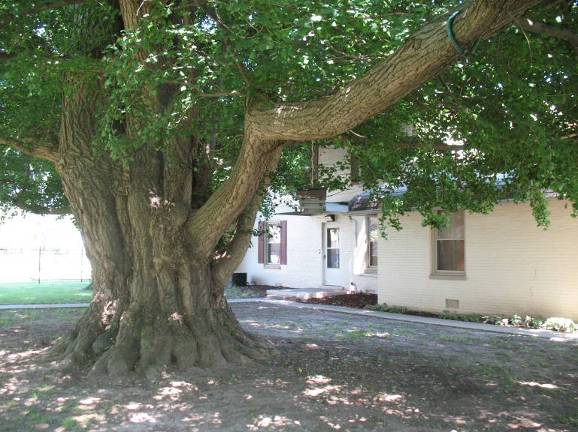
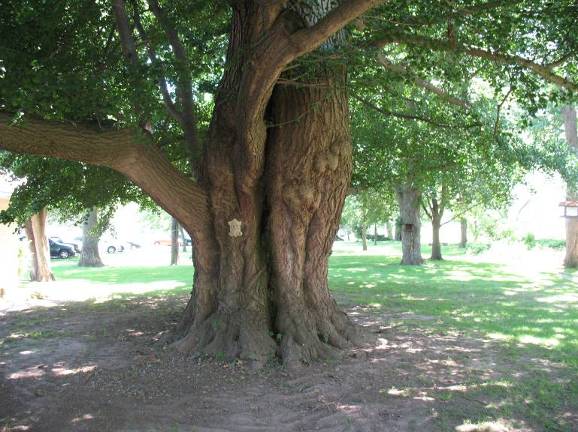
Freemont Ginko
The next tree, also in Fremont, was an immense ginkgo a whopping 20
feet in
girth! I have never seen such a huge specimen and wonder where the
largest
in the US may be. I measured the height after lots of searching on
this wide
tree to 87.5 feet and the spread was an impressive 88' (long spread
105
feet!). The owner was very proud of it! He did not know when it was
planted
but the structure dates to 1865. A large, low limb had recently
fallen off
unfortunately but no one counted the growth rings. A nearby Celtis,
perhaps
an introduced Celtis laevigata (sugarberry) was an impressive 11.8'
CBH X
93.5' tall.
That concluded my few days of tree-time in Ohio and look forward to
the next
trip. I hope Tom Diggins can help support Brian Riley and I
encourage any
ENTS out his way to lend a hand. I have invited Brian to the
upcoming ENTS
events and hope he can find the time to join us.
Will Blozan
== 2 of 4 ==
Date: Sun, Jul 20 2008 4:11 pm
From: "Edward Frank"
Will,
Excellent account of your trip. Not perfect though.... How could you
not photograph the Hackberry? Have you been hanging out with Bob L.
again?
Some very nice trees in your report and it would be great to get
Brian Riley involved with laser measurement. Did you prod him to
join ENTS? I don't remember seeing his name on the list.
The American Chestnut was cool. I take it this was the same chestnut
listed in the treehugger article:
http://www.treehugger.com/files/2008/03/you-cant-hug-you-can-love-chestnut.php
If so then the dimensions posted there were remarkably good.
There is great potential for big trees in Ohio. Carl and I measured
a black walnut to 11.2 feet girth and 126.9 high (likely higher) at
Holden Arboretum. There are a number of big trees there in old
growth patches. I am told there are some really old black gums in
one of the Cleveland Metro Parks. Tom Diggings, Steve Galehouse, and
Randy Brown also have posted some good locations and big trees from
the state. Making more inroads and progress there would be
fantastic.
Ed
== 3 of 4 ==
Date: Sun, Jul 20 2008 5:17 pm
From: "Will Blozan"
Ed,
The hackberry was not particularly photogenic. A fence was very
close on one
side and saplings obscured the other side. I think it is a common
stop for
"relief" by passing pedestrians. Yes, same chestnut you
linked. I found
Brian's tape and clinometer heights to be quite accurate in the
limited
number of trees I remeasured. He does a great job!
Will
== 4 of 4 ==
Date: Sun, Jul 20 2008 8:26 pm
From: Randy Brown
Well they seem to have improved things then. I lived in findlay
about 8 years ago and used to jog by that tree every so often. At
that time they used to have a dumpster sitting in front of it. Last
time I was there ~ 3 years ago it had some big conks growing out of
one side of it, so it looks like it has some significant decay going
on somewhere.
And yeah I agree, it does look like the fusion of two trunks.
== 2 of 7 ==
Date: Mon, Jul 21 2008 3:46 am
From: "Will Blozan"
Randy,
Yep, it had conks scattered throughout. I commented to Brian that it
wouldn't be around much longer.
Will
== 3 of 7 ==
Date: Mon, Jul 21 2008 7:45 am
From: "Edward Frank"
Randy, Will,
What is a conk?
Ed
== 4 of 7 ==
Date: Mon, Jul 21 2008 4:38 pm
From: Randy Brown
I like to think of them as mushrooms growing out of the sides of
trees.
I stumbled across this more technical definition(but I don't think
it
tells me anything. ;)
"A term used in forestry for basidiomata of polypores on
trees."
http://www.forestpathology.org/decay.html
== 6 of 7 ==
Date: Mon, Jul 21 2008 8:13 pm
From: "Jess Riddle"
Will,
Neat post, and seeing the photos is great. The ash and chestnut are
especially impressive to me, and the Ohio buckeye probably would be
too if I were more familiar with the species. I am a little confused
about the status of the buckeye since the 2008 national register
list
a much greater circumference for a tree in Illinois and does not
list
the Ohio tree. I've also added both buckeyes, the chestnut, the ash,
and the sassafras to the maximum dimension list. What height should
be included for the sassafras; the photo caption and list of
measurements have two different numbers?
Jess
== 7 of 7 ==
Date: Mon, Jul 21 2008 9:23 pm
From: James Parton
Ed,
Dad and I have always called those kind of fungi " Wood Ears
".
JP
== 4 of 7 ==
Date: Tues, Jul 22 2008 12:44 pm
From: djluthringer@pennswoods.net
Awesome trees, dude,
I like the sassafras. You got a sweet ash there too.
Yet again, there's not a tree record that Cook can hold that Will
doesn't have
to go out and promptly break... That's alright, records are meant to
be
broken. I must admit that the breaking of the Cook Forest chestnut
height
record was inevitable, I guess I was just wishing that it would've
been another
PA tree. There is a "tall one" that's reported in the
center of the state that
I still have to run down yet. We'll see, a 90footer is coming. I'm
hoping
we'll find one that breaks 100ft somewhere in PA.
Dale
==============================================================================
TOPIC: Great trees of Ohio
http://groups.google.com/group/entstrees/browse_thread/thread/796cba77dc829f54?hl=en
==============================================================================
== 1 of 3 ==
Date: Sun, Jul 27 2008 8:47 am
From: Randy Brown
Will,
One note about the ash tree. My parents actually live in the Findlay
area and attended a presentation about EIB where they discussed
treating a very large ash tree (probably this one). I think they
said
the cost was going to be on the order $500. So I suspect at least
this one will be saved.
== 2 of 3 ==
Date: Sun, Jul 27 2008 8:53 am
From: Randy Brown
Jess,
The buckeye is pretty huge. Generally you don't see too many big
ones
around because their foliage is toxic to livestock, but you do find
them in abundant patches in the understory. In the early part of the
century, most woodlots hosted some kind of grazing (you can still
find
the old wire fences at the edges of nearly every woodlot, and if you
are unlucky, they go through the middle of a woods and send your
nose
straight into the ground if they find you first. Just in general
observation a 'big' buckeye is ~1/2 that diameter.
== 3 of 3 ==
Date: Sun, Jul 27 2008 9:02 am
From: "Will Blozan"
Very cool!
|